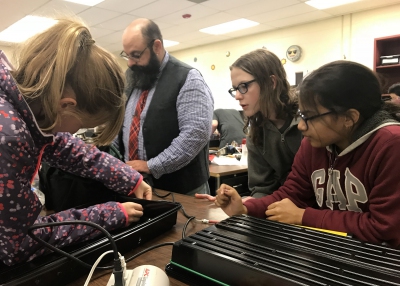
Writer: Mr. Robert Nathan Gregory, MSU Extension Service
STARKVILLE, Miss. -- Growing food on Earth is challenging enough, but two Armstrong Middle School robotics teams are exploring the cultivation of leafy greens in space.
The Gardeners of the Galaxy, an all-girl group of 10 sixth- and seventh-graders at Armstrong, recently won a First Lego League championship and Global Innovation Award at a qualifying tournament in Jackson after developing a spacecraft growth chamber system that yields romaine lettuce. With the win, the team advanced to a statewide competition.
The system involves an inflatable greenhouse with a small rooting packet called a “plant pillow,” an irrigation unit that recycles water, a reflective film covering, and LED lamps that serve as a substitute for sunlight.
“There are red, blue and green LED lights inside with a reflective shield above it,” said team member Sanjhbati Mukherjee, a seventh-grader. “The red and blue lights help the plants grow, and the green lets you see the plant without them looking like they’re purple or turquoise. The light bounces off the reflective surface and hits the plants so none of the light goes to waste.”
One more notable detail on their road to the title is who the students enlisted for guidance in constructing their space garden: plant specialists with the Mississippi State University Extension Service.
The Space Farmers, an all-boy team from Armstrong Middle School, also built a plant growth chamber and competed in a previous event. Like the girls, their goal was to grow lettuce, only on the surface of Mars instead of on the way there. They built a low-tunnel greenhouse with compartments for six different soil types, including one with simulated Martian soil they purchased.
Geoff Denny, MSU assistant Extension professor and director of the Mississippi State Trial Gardens, was one of the volunteer mentors for the teams.
“They keep thinking I’m doing them a special favor, but this is what I do,” Denny said. “My normal day is answering questions like how to build a greenhouse. Except for the planet, it’s pretty much the same.”
Extension plant specialist Casey Barickman and MSU plant and soil sciences professor Michael Cox worked with the teams along with Denny.
“If we saw an idea that would work with our project, Dr. Denny would try to incorporate all our ideas but also give opinions on what he thought would work,” said sixth-grader Addison Davis.
The First Lego League calls on teams to solve real-world problems incorporating STEM principles -- science, technology, engineering and math. Each challenge has three parts: a robot design, a completed project, and a demonstration of core values, such as teamwork. The growth chambers are the project portion of the challenge.
“The girls researched the International Space Station and found that fresh lettuce provided the most health benefits and mental wellness of any food during prolonged orbit,” he added. “With the guys, I worked with them to make a low greenhouse to trap enough heat and atmosphere to grow the crop.”
Denny said what sets the teams’ projects apart from their peers is a low-tech approach.
“Usually, it’s best not to over-engineer a system. Having something simple means you know how it works and it’s easy to fix,” he said. “The system the boys are using has worked on Earth for a couple of hundred years. All they had to do was add a few details to create a project that will be robust enough to use during the colonization period of the Martian surface.”
The all-girls’ team is in the process of making tweaks to their project as they prepare for the next competition.
“We’re going to add a water filter and pipe so the irrigation system is better,” Mukherjee said. “We’re also adding some UV lights to the pipe so the water gets filtered and so there is no bacteria on the plants.”
Source: Students use STEM concepts in space garden prototype